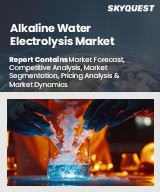
알칼리 수전해 세계 시장 규모는 2023년에 1억 4,520만 달러, 2024년 1억 7,206만 달러에서 2032년에는 6억 6,901만 달러로 성장하고, 예측 기간(2025-2032년) CAGR은 18.5%를 보일 전망입니다.
세계 알칼리 수전해 시장은 청정 에너지 솔루션과 건강한 물에 대한 수요 증가에 힘입어 강력한 성장세를 보이고 있습니다. 이러한 수요는 알칼리 전해조의 신뢰성, 확장성, 대체 시스템 대비 낮은 운영 비용으로 인해 다양한 산업 분야에서 그린수소에 대한 관심이 높아지는 것과 맞물려 있습니다. 청정 에너지에 대한 정부 및 업계의 지원은 알칼리성 전해조 채택을 더욱 촉진하고 있습니다. 촉매 및 전기화학 물질의 지속적인 기술 혁신으로 에너지 효율과 수명이 크게 향상되었습니다. 제로 갭 전해조 및 소형 전해조와 같은 첨단 기술은 재생에너지원과의 원활한 통합을 가능하게 하고, 유연성과 자동화를 촉진하는 동시에 확장성을 높입니다. 이러한 신흥 경제국들은 총체적으로 시장 확대를 추진하며 수소경제 전체의 성과를 높이고 있습니다.
Global Alkaline water electrolysis Market size was valued at USD 145.2 million in 2023 and is poised to grow from USD 172.06 million in 2024 to USD 669.01 million by 2032, growing at a CAGR of 18.5% during the forecast period (2025-2032).
The global alkaline water electrolysis market is witnessing robust growth fueled by the rising demand for clean energy solutions and healthier water options. This demand is paralleled by increased interest in green hydrogen across various industries, as alkaline electrolysers are recognized for their reliability, scalability, and lower operational costs compared to alternative systems. Government and industry support for clean energy initiatives is further propelling the adoption of alkaline electrolysers. Ongoing innovations in catalysts and electrochemical materials have significantly enhanced energy efficiency and longevity. Advanced technologies such as zero-gap and compact electrolysers allow for seamless integration with renewable energy sources, fostering flexibility and automation while boosting scalability. These developments are collectively driving market expansion and enhancing overall performance in the hydrogen economy.
Top-down and bottom-up approaches were used to estimate and validate the size of the Global Alkaline water electrolysis market and to estimate the size of various other dependent submarkets. The research methodology used to estimate the market size includes the following details: The key players in the market were identified through secondary research, and their market shares in the respective regions were determined through primary and secondary research. This entire procedure includes the study of the annual and financial reports of the top market players and extensive interviews for key insights from industry leaders such as CEOs, VPs, directors, and marketing executives. All percentage shares split, and breakdowns were determined using secondary sources and verified through Primary sources. All possible parameters that affect the markets covered in this research study have been accounted for, viewed in extensive detail, verified through primary research, and analyzed to get the final quantitative and qualitative data.
Global Alkaline water electrolysis Market Segments Analysis
Global Alkaline water electrolysis Market is segmented by Type, Application and region. Based on Type, the market is segmented into < 10 m3/h, < 30 m3/h, < 50 m3/h, < 80 m3/h and >= 80 m3/h. Based on Application, the market is segmented into Power Plants, Steel Plants, Electronics and PV, Industrial Gases and Others. Based on region, the market is segmented into North America, Europe, Asia Pacific, Latin America and Middle East & Africa.
Driver of the Global Alkaline water electrolysis Market
The global alkaline water electrolysis market is being propelled by the introduction of national hydrogen initiatives and financial support from various governments. These strategies are facilitating the adoption and implementation of alkaline water electrolyzers, encouraging sectors to transition to low-carbon production methods. Policies often incorporate substantial tax incentives, grants for large-scale projects, and mandates for hydrogen blending, all of which help mitigate investment risks for manufacturers and project developers. This supportive regulatory environment is vital in fostering innovation and expanding the deployment of clean hydrogen technologies, ultimately driving growth in the market.
Restraints in the Global Alkaline water electrolysis Market
The global alkaline water electrolysis market faces significant constraints primarily due to the high initial investment required for equipment and infrastructure setup. This financial barrier poses a considerable challenge for small and medium-sized enterprises, particularly when juxtaposed with more established hydrogen production methods like steam methane reforming, which may involve lower upfront costs. Although the long-term operational expenses of alkaline water electrolysis tend to be more favorable, the substantial initial capital outlay continues to impede widespread adoption, especially in regions with developing economies where access to funding may be limited.
Market Trends of the Global Alkaline water electrolysis Market
The global alkaline water electrolysis market is witnessing a significant upward trend, driven by the escalating emphasis on green hydrogen production across various countries. Governments and industries are collaboratively advancing hydrogen strategies, mandating funding for new initiatives aimed at enhancing renewable energy sources. Alkaline water electrolysis emerges as a favored technology due to its efficiency in producing clean hydrogen with minimal environmental impact, aligning with global climate targets. This focus on sustainability is not only addressing pollution concerns but also sparking opportunities in the clean energy sector, thereby propelling the growth of the alkaline water electrolysis market on a global scale.